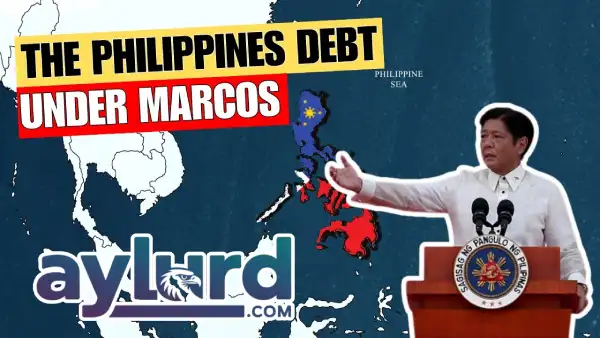The Dual Impact: Credit Ratings and Rising National Debt
The Philippines’ credit rating improvements are impressive, with the country now enjoying stronger credit ratings than in past administrations. This has lowered borrowing costs, which would typically benefit both the government and private sectors. However, these improvements are juxtaposed with a Rising National Debt. Here’s what you need to know:
🔑 Credit Rating Upgrades: A Short-Term Boon
The credit rating upgrades under the Marcos administration reflect investor confidence in the country’s economic management. This confidence results in lower interest rates for loans and improved access to foreign capital markets. These benefits have been crucial for financing essential projects and government operations.
💥 The Rising National Debt: A Long-Term Challenge
However, with the rise in credit rating comes a sharp increase in borrowing. As of mid-2025, the Philippines’ national debt has reached an all-time high, over ₱14 trillion—the worst debt burden in the nation’s history. This surge is largely fueled by:
- Ayuda programs during the pandemic and economic crises
- Government infrastructure spending for future growth
- Borrowed funds to cover operational costs
Despite the credit rating upgrades, higher borrowing costs and the increase in national debt create a fiscal dilemma. The growing debt means that a larger portion of the national budget will need to be allocated toward debt servicing rather than critical investments in education, healthcare, and poverty alleviation.
💡 Economic Implications of Debt Reliance
1. Debt Servicing and Budget Constraints
The increase in debt means higher interest payments on government loans. This means the Philippines must allocate a greater portion of its budget to servicing debt rather than spending it on other public services, such as healthcare, education, and infrastructure development. This limits the government’s ability to invest in its people and reduce poverty.
2. Political Challenges
The use of Ayuda programs during the Marcos administration has garnered praise from those who directly benefit from the assistance. However, this has also raised concerns over whether the distribution of aid is being used politically, especially with upcoming elections on the horizon. By increasing aid during times of crisis, the Marcos administration has solidified its political base, but at the cost of long-term fiscal health.
3. Potential Risks of Further Borrowing
If debt continues to climb, future generations may bear the burden of higher taxes and cutbacks in essential public services. Without structural reforms to reduce reliance on borrowed funds, the country could face an economic slowdown when global conditions tighten.
📉 Balancing Debt with Long-Term Growth: The Way Forward
The Philippines’ current economic model—fueled by short-term fiscal aid through Ayuda and borrowed funds—is reaching a critical juncture. To maintain credit upgrades and continue its economic growth, the government must begin to shift towards a more sustainable model focused on:
- Job creation and poverty reduction
- Private sector investments that drive inclusive growth
- Sustainable infrastructure projects that pay off in the long term
The government needs to balance the short-term benefits of Ayuda with long-term policies that stimulate the economy without further increasing the debt burden.
✅ Conclusion: Rising National Debt
The Philippines stands at a crossroads. On one hand, credit ratings have soared, bringing with them opportunities for lower borrowing costs and increased investor confidence. On the other, the country faces an unprecedented national debt that must be managed carefully to avoid long-term fiscal strain.
President Marcos Jr. has the opportunity to leverage credit upgrades and positive ratings to secure investments in sustainable development. However, if the administration continues relying heavily on Ayuda and borrowed funds, it could face financial instability in the years ahead.
The key challenge for the Marcos administration is to ensure that economic aid does not become a political tool but instead serves as part of a comprehensive, long-term plan for building a self-sustaining economy.
⚠️ Rising National Debt – Disclaimer
This content is based on publicly available data as of June 2025. Economic policies and conditions are subject to change rapidly, and readers should consult official sources for real-time updates.
🚀 What to Watch
- Stay informed about upcoming elections and how Ayuda programs are used in political campaigns.
- Watch for shifts in fiscal policy that aim to address the country’s long-term debt management.
- Monitor new job creation policies that could reduce dependency on borrowed funds and aid distribution.
You May Also Like:

Ken Lurd, born Ken Martin, is a seasoned writer and content creator from the Philippines with over two decades of experience in storytelling, digital media, and creative strategy. Now in his 40s, Ken has built a solid reputation for blending real-life insight with engaging narratives that resonate with Filipino and global audiences alike.
From lifestyle blogs and social commentaries to thought-provoking essays and branded content, Ken’s work reflects depth, authenticity, and a passion for connecting with readers. Whether he’s writing under the name Ken Lurd or speaking at content workshops, his mission remains the same: to inform, inspire, and ignite meaningful conversations.
When he’s not writing, Ken enjoys local travel, coffee-fueled brainstorming sessions, and mentoring up-and-coming creators across the country.
Follow and Subscribe for Daily Updates!Facebook: AyLurdTikTok: @AylurdYouTube: AyLurd



